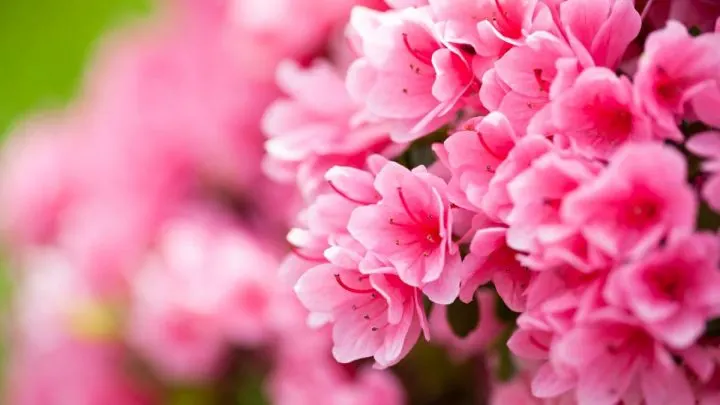In today’s article, we will talk about azalea flowers, more precisely about 9 types of azaleas. If your garden has recently lacked woody shrubs, especially those that are colorful, and have a wonderful shape and smell, then this article will be of great interest to you.
Among the 9 types of these beautiful flowers, you will be able to find at least one dream flower of azalea for your garden.
Dark red, purple, violet, light or dark pink, yellow, the choice is yours, and we offer you all the information about each type.
Your garden (garden quotes) will be richer in wildlife after you plant these flowers as they greatly attract butterflies, hummingbirds, and bees. Let’s learn in detail all about the 9 types of azalea flowers.
1. Rhododendron Flowers And Its Pink Petals
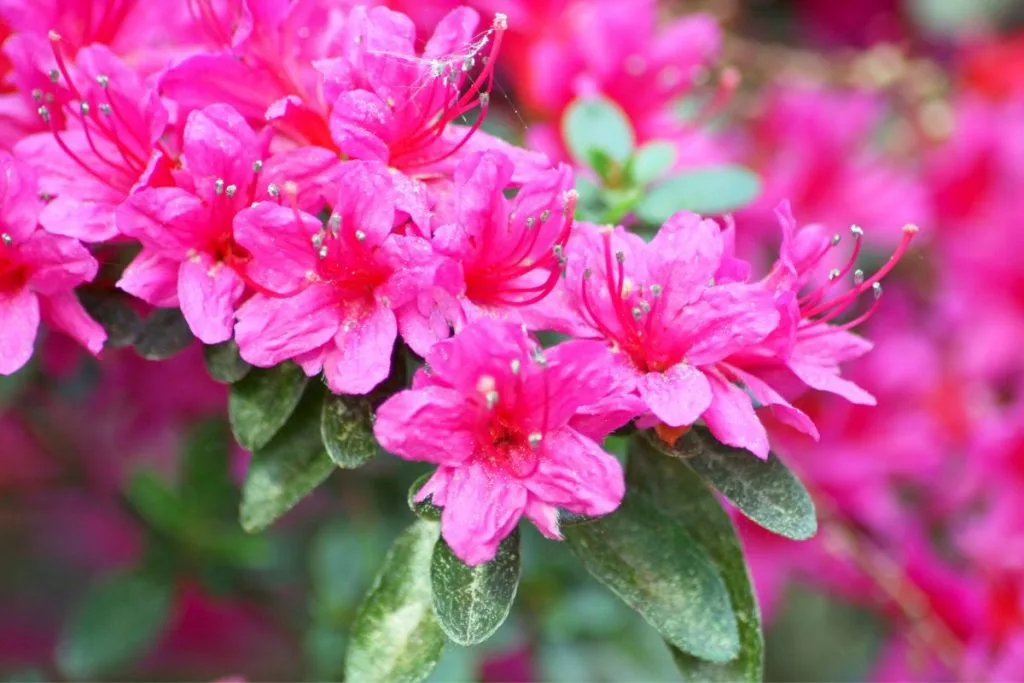
We’ve put this type of azalea flower at the beginning for a reason since it is considered one of the most beautiful types of these flowers. Its beautiful salmon pink color will win you over the first time you meet it and you will want a garden full of just these flowers. Genus rhododendron is native to India. It is one of the deciduous species.
Light conditions
In early spring and late spring when the plant is usually in its blooming season, it prefers light morning sun and a bit of afternoon shade. Of course, if you planted it in a place with no shade and only full sun for example, then simply check your plant often. If grown inside, azalea flowers like an east-facing window location.
Watering Needs
Most azalea bushes don’t like too much water. Whether they’re grown inside or outside, they like their soil medium drained with tap water or rainwater it doesn’t matter much. In the garden, azaleas can be watered with a sprinkler that’s at least 5 to 6 feet far from them so it doesn’t ruin their petals with water pressure.
Soil Type
The soil type for most azaleas is sandy loam to clay loam. Perlite soil can work as well. They don’t prefer acidic soils so the range of pH should be between 6 and 6.5.
Fertilizer
For azalea varieties, fertilizers rich in nitrogen will help their leaves’ growth and give that special green foliage color. They need to be fertilized once a year in their blooming season, especially if grown as container plants.
Propagation
All azalea types are propagated by a method of separating roots. Once you took out the plant from the soil, gently divide the roots. Plant the roots in new well-drained soil.
2. Obtusum Azalea’s Dark Green Foliage With Pink Flowers
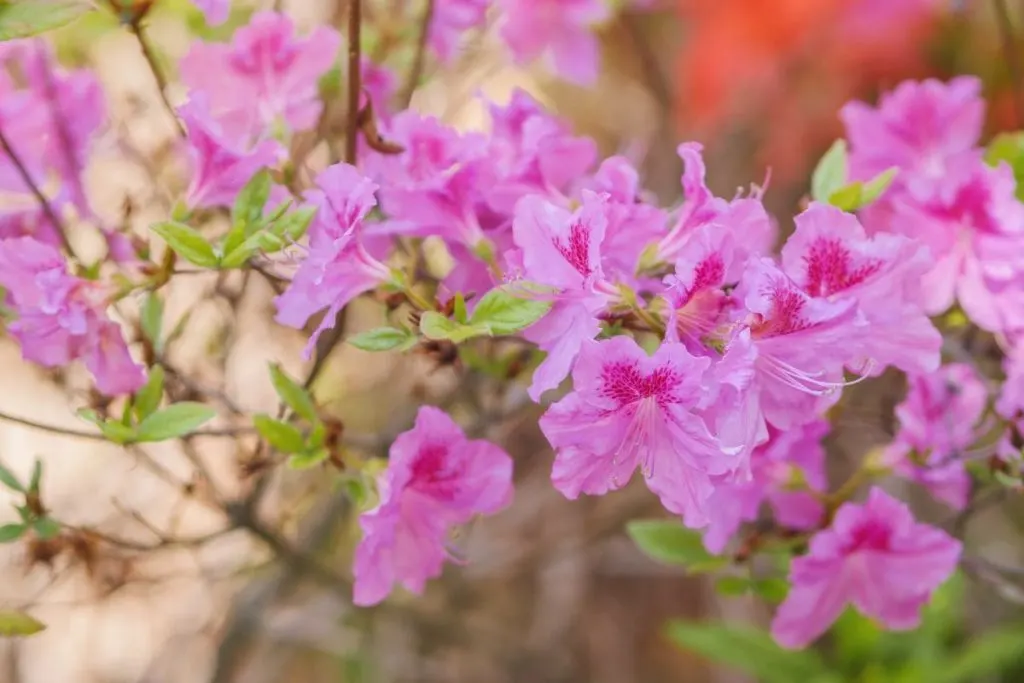
This is one of the hybrid azaleas that you’ll completely love! Once you plant azaleas obtusum in your garden, in about a month you’ll have a small perfect pink shrub in your yard. Their flowers are very similar to lilies. These species are native to North America.
Light conditions
The beautiful dark pink flowers will adore the mild light and a little morning sun. I would still plant it somewhere where the strong sun will set after 1 p.m. and that way you won’t have any problems. If you grow them indoors, a south-facing window is a great choice.
Watering Needs
Its deep pink flowers love medium to high moisture. It’s very similar to autumn lilac with its watering needs. As with most plants, excessive watering causes root rot. They prefer rainwater if grown outside. Inside, tap water is just fine.
Soil Type
Perlite, clay soil, and a bit of soggy soil will be the best choices for this type of azalea plant. This type doesn’t like sandy soils, so make sure you avoid those. Azaleas native to North America mostly don’t prefer sandy soils.
Fertilizer
Fertilize it in mid-spring and early summer with fertilizers rich in Nitrogen. If you’re using soggy soils for them, then liquid fertilizers aren’t the smartest choice. 10-10-10 general fertilizer is also good.
Propagation
All azalea types are propagated by a method of separating roots. Once you took out the plant from the soil, gently divide the roots. Plant the roots in new well-drained soil.
3. Fireball And Its Dark Orange Flowers Types Of Azaleas
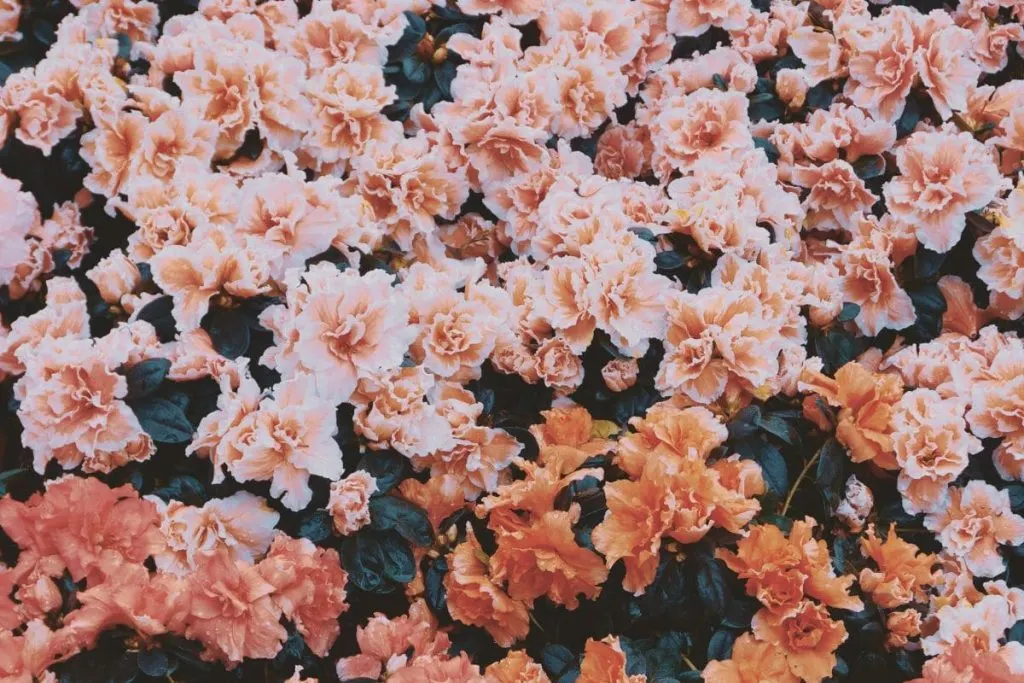
You’ll adore these funnel-shaped flowers and their rich orange color. If your garden is full of green plants, this will break that monotony and you’ll be a proud owner of a heavenly beautiful garden. They are perfect spring flowers that thrive well in shade gardens. It’s native to Australia.
Light conditions
These deciduous shrubs work well in part shade and part bright light. Most azaleas don’t like full sun but they need and love sunlight. Its olive green leaves also need bright light for healthy growth. If indoors, place it in the southwest position.
Watering Needs
Evenly moist soil during the whole year is what this type of azalea needs. Distilled, rainwater, or tap water, the choice is yours, it doesn’t matter much. Azaleas tend to look droopy in winter, so don’t be afraid to water them then.
Soil Type
Peat moss is a great choice along with perlite and clay soil. pH rate should be between 5 and 6.5. They hate acidic soils.
Fertilizer
Fertilize them in late spring with 20-20-20 general fertilizer or a regular houseplant fertilizer. Don’t fertilize them over winter.
Propagation
All azalea types are propagated by a method of separating roots. Once you took out the plant from the soil, gently divide the roots. Plant the roots in new well-drained soil.
4. Types Of Azaleas – Formosa Azalea And Lovely Violet Flowering Shrubs
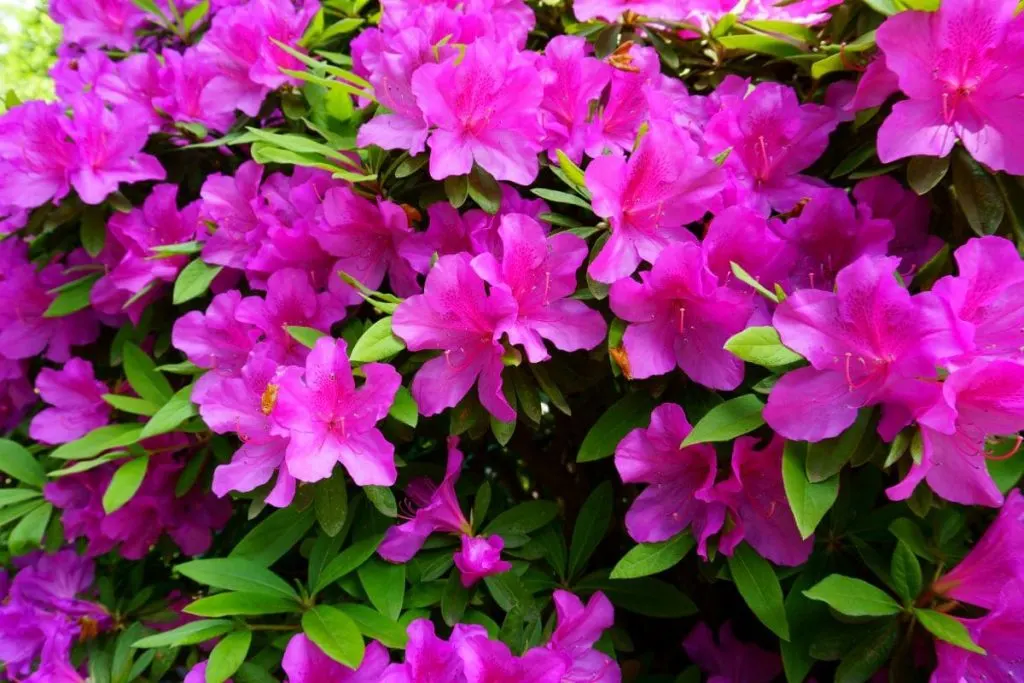
If you prune this type of azalea in the springtime, during summer with its wonderful dark violet colors, it will look like you have a Japanese garden behind your house. These easy-to-maintain flowers are native to south India but they grow well in any region with temperatures above 50 F.
Light conditions
These lovely flowers with rounded growth habits prefer bright indirect light all the time. Its flowers are very sensitive so you’ll have to make sure you plant them in such a location that doesn’t have much full sun during the day. Direct sun can easily kill them.
Watering Needs
Water them regularly – 2 times in 10 days with a sprinkler or water hose. They are not picky about water type as almost all the types of azalea varieties. Too much water can cause a droopy appearance of the plant.
Soil Type
Unlike the types of azalea we talked about above, this azalea type loves acidic, moist, well-drained soil. Of course, not too much water because as we said, plants might look droopy. Soil should also be high in organic matter.
Fertilizer
Fertilizers such as general 15-15-15 fertilizers are more than perfect for this azalea type.
Propagation
All azalea types are propagated by a method of separating roots. Once you took out the plant from the soil, gently divide the roots. Plant the roots in new well-drained soil.
5. Gibraltar As A Royal Azalea For Your Garden
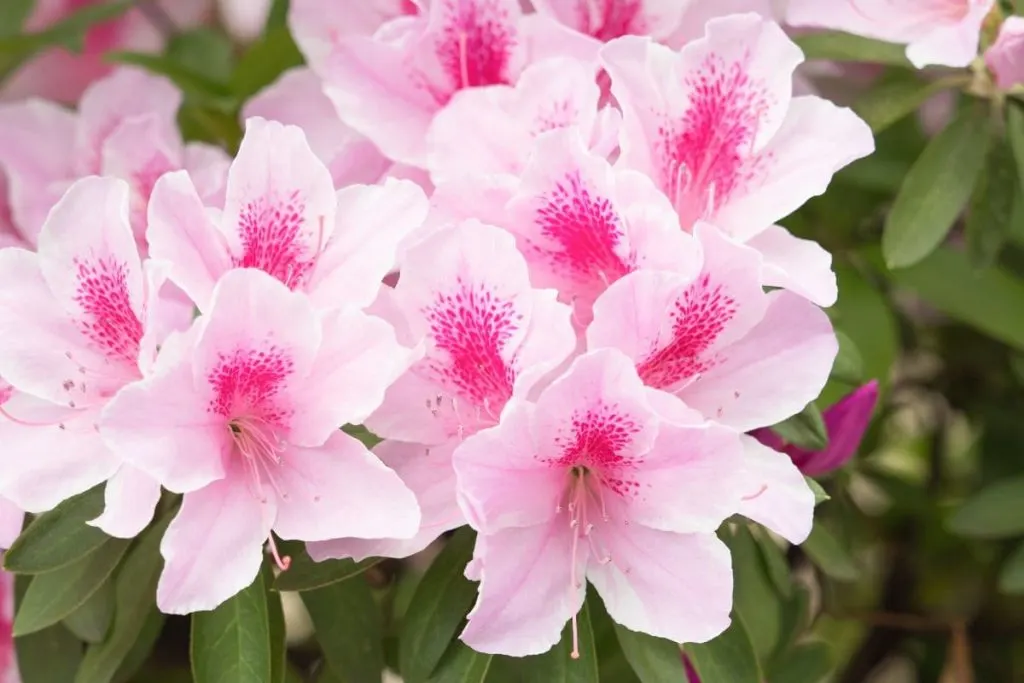
This is a type of rhododendron genus, also a deciduous flowering shrub, and has the most amazing orange flowers. The flowers look like a grouping of smaller flowers in one. one flower looks like a small bouquet. This type is native to the United States and it is found mostly in cottage gardens.
Light conditions
For optimal growth and blooming of Gibraltar azalea, you’ll need at least dappled sunlight for it. What they prefer the most is bright light combined with a bit of shade. Too much sun causes spots on their leaves and they can easily burn.
Watering Needs
During hot summer days water them twice a week, but not too much. Since you’ll water them twice, make sure you leave some space for their roots to breathe as well. Tap and rainwater work best.
Soil Type
They don’t thrive well in cold hardy regions, and due to that, the soil type they like the most is sandy to loamy soil types. pH should be between 6 and 7.
Fertilizer
As the ones with large yellow flowers, they prefer 15-15-15 fertilizers and even 20-20-20 fertilizers the most. Plants bloom the best when fed with these types of fertilizers.
Propagation
All azalea types are propagated by a method of separating roots. Once you took out the plant from the soil, gently divide the roots. Plant the roots in new well-drained soil.
6. Lemon Light Azalea Blooms – Types Of Azaleas
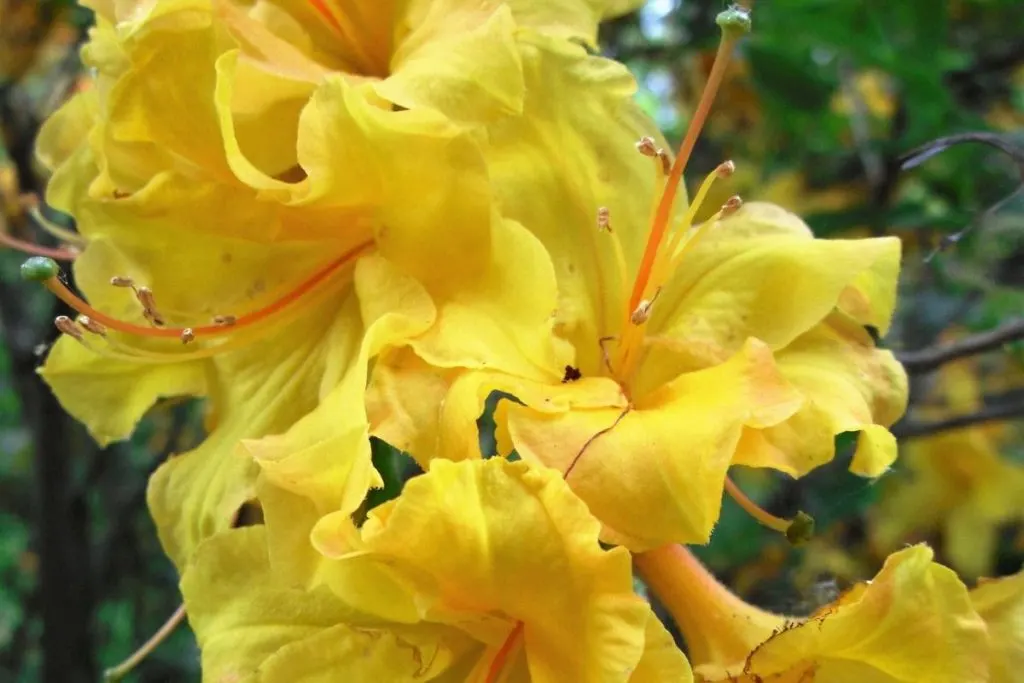
They are very similar to light pink azalea species. They both have very similar shapes of flower petals. Trumpet-shaped flowers are exactly what your garden needs at this moment. These flowers also have amazing fragrances and attract hummingbirds, butterflies, bees, and even deer sometimes. They are native to the United States.
Light conditions
Lemon light azalea needs sun to thrive well, but afternoon sun can do more damage than good, so the best position is the one with lots of morning sun and bright indirect sunlight during afternoon hours. If grown indoors, grow it on an east-facing window and change the location to the south in the afternoon.
Watering Needs
Twice or even three times in 15 days, depending on the temperature and humidity. Just like all azalea types, they prefer rainwater and water. Standing water can kill it, so watch out.
Soil Type
Lemon-light flowers prefer rich, moist, acidic soils. pH rate can be between 5 and 6.5.
Fertilizer
You can actually buy a fertilizer that’s specially made for lemon light azalea, so it’s best to go with that one.
Propagation
All azalea types are propagated by a method of separating roots. Once you took out the plant from the soil, gently divide the roots. Plant the roots in new well-drained soil.
7. Bollywood And Their Dark Pink Petals
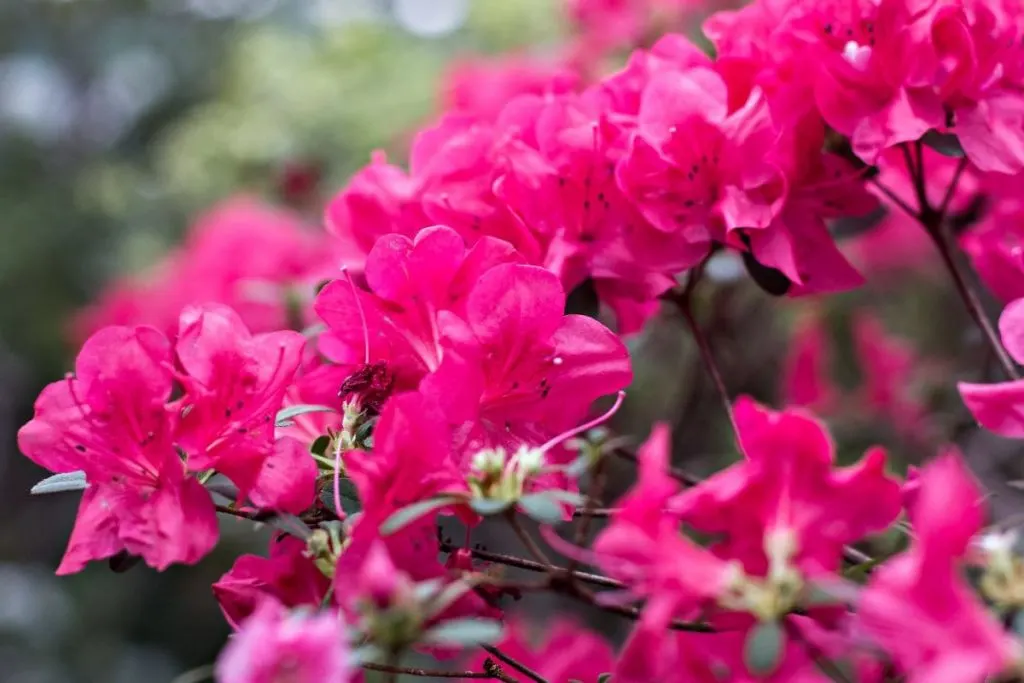
This flower is, in a word, drama! The leaves are colorful, dark-light green, beautiful, and only the flowers! Dark pink combined with light pink in the center of the flower will add pizazz to any garden where it is planted. Expect these wonderful flowers already in early spring. It’s native to India.
Light conditions
They like a lot of mild sun and afternoon shade. If you grow this plant indoors, and of all the types of azalea flowers, this one is the easiest to grow indoors, then place it in the southwest position.
Watering Needs
A lot of water, but 15 to 18 days apart. Always do a finger check before you water your plants. The plant does not like standing water and, like the species above, can easily kill it.
Soil Type
The type of soil that this type of plant likes the most is sandy and clay soil. It does not like very acidic soils and the pH ratio should be between 6 and 7. Soils rich in organic matter also work well.
Fertilizer
Controlled-release fertilizer works best for this type of azalea plant, as well as 15-15-15 fertilizer.
Propagation
All azalea types are propagated by a method of separating roots. Once you took out the plant from the soil, gently divide the roots. Plant the roots in new well-drained soil.
8. Wonderful White Cascade Type Of Azalea Plants

Snowy white flowers and your garden are finally everything you need! Another funnel-shaped flower that has such an elegant look. Flowers bloom in mid-spring and early summertime. They work great as flowering hedge flowers. These flowers are native to Northern America and China.
Light conditions
Mild bright sun is necessary for the growth of this plant, any other type of sunlight will easily kill it. Make sure that it is not exposed to direct sunlight, especially on hot summer days.
Watering Needs
Water this plant once every 10 days, unlike other species, it does not require as much water and is much more tolerant of dry periods than others. It is sensitive and too much water can kill it very quickly, faster than a lack of water.
Soil Type
The type of soil that suits the white cascade type is the same one that the lemon light type likes, which is sandy and clay soil with a pH ratio between 6 and 7.
Fertilizer
These woodland edge flowers prefer 15-15-15 general fertilizers and are high in nitrogen fertilizers.
Propagation
All azalea types are propagated by a method of separating roots. Once you took out the plant from the soil, gently divide the roots. Plant the roots in new well-drained soil.
9. You Will Fall In Love With Chinzan Beautiful Azaleas
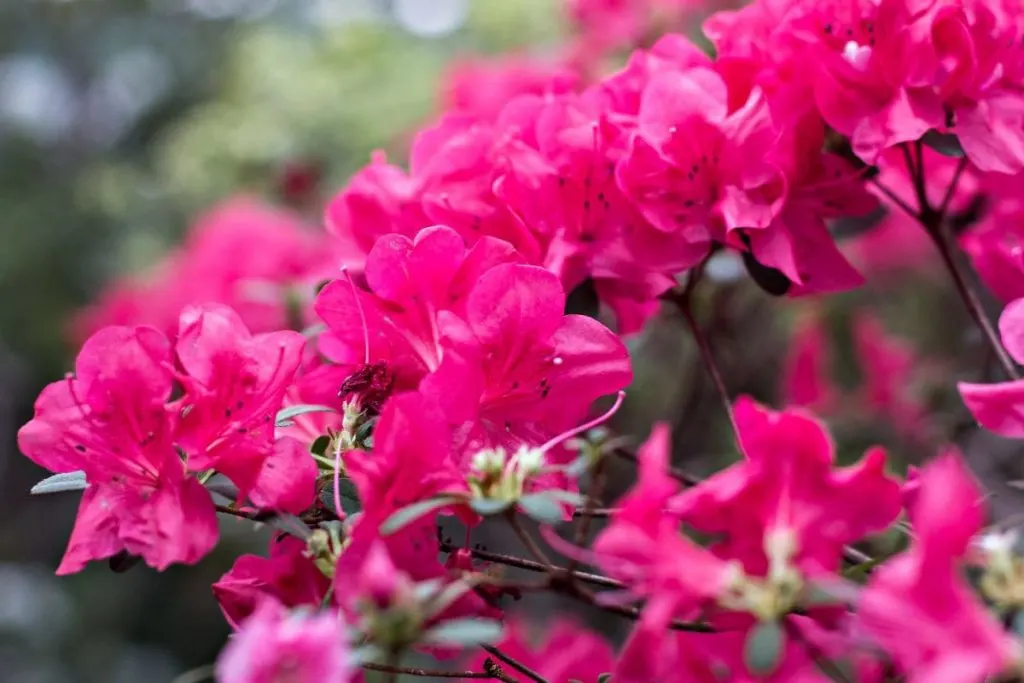
Another amazing example of azalea varieties that is perfect for cottage gardens. Once you prune this plant it will stay in its pruned shape for months. They have lovely pale pink to dark pink flowers very similar to petunia flowers. These azaleas are native to Japan. They make great shrub borders plants and woodland gardens.
Light conditions
Provide your chinzan azalea bushes with direct sunlight in the morning and a bit of shade in the noon and afternoon hours, They don’t like the direct sun in the afternoon, it can easily burn their leaves and even stems sometimes.
Watering Needs
Water this lovely plant twice a week when hot temperatures occur, usually, you can water it once in 10 days with rainwater or tapwater.
Soil Type
Clay, loamy, soggy, perlite, and peat moss, almost any soil type suits this azalea type. They hate dry soils so avoid that. High in organic matter soils are their favorite types.
Fertilizer
Unlike other azalea varieties, this plant can be fertilized during late winter and early spring too. Organic-based fertilizers work the best.
Propagation
All azalea types are propagated by a method of separating roots. Once you took out the plant from the soil, gently divide the roots. Plant the roots in new well-drained soil.


